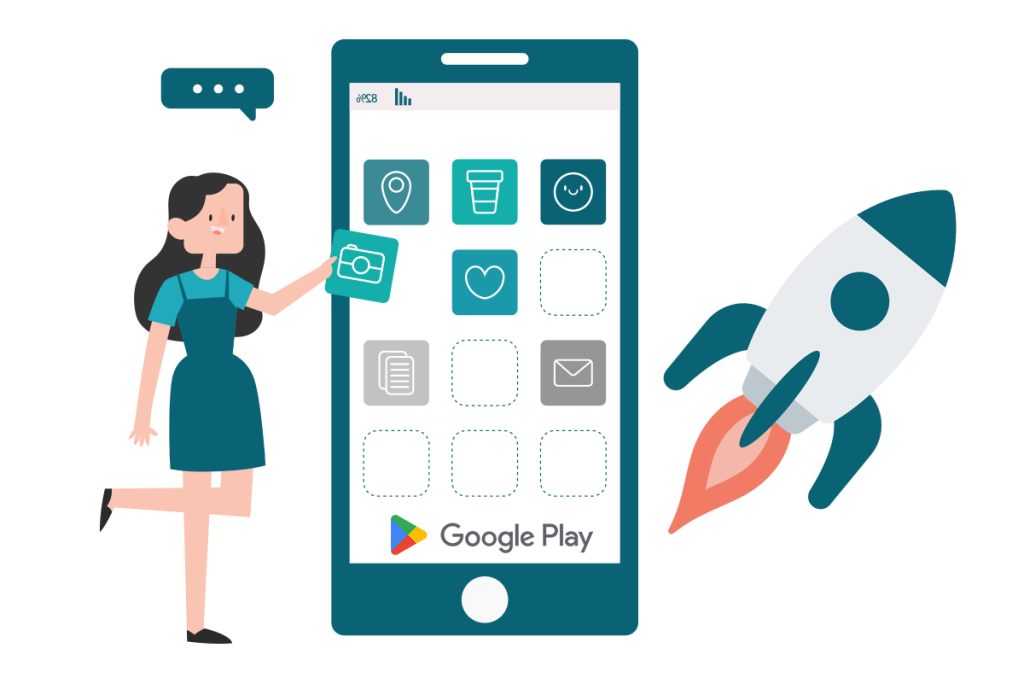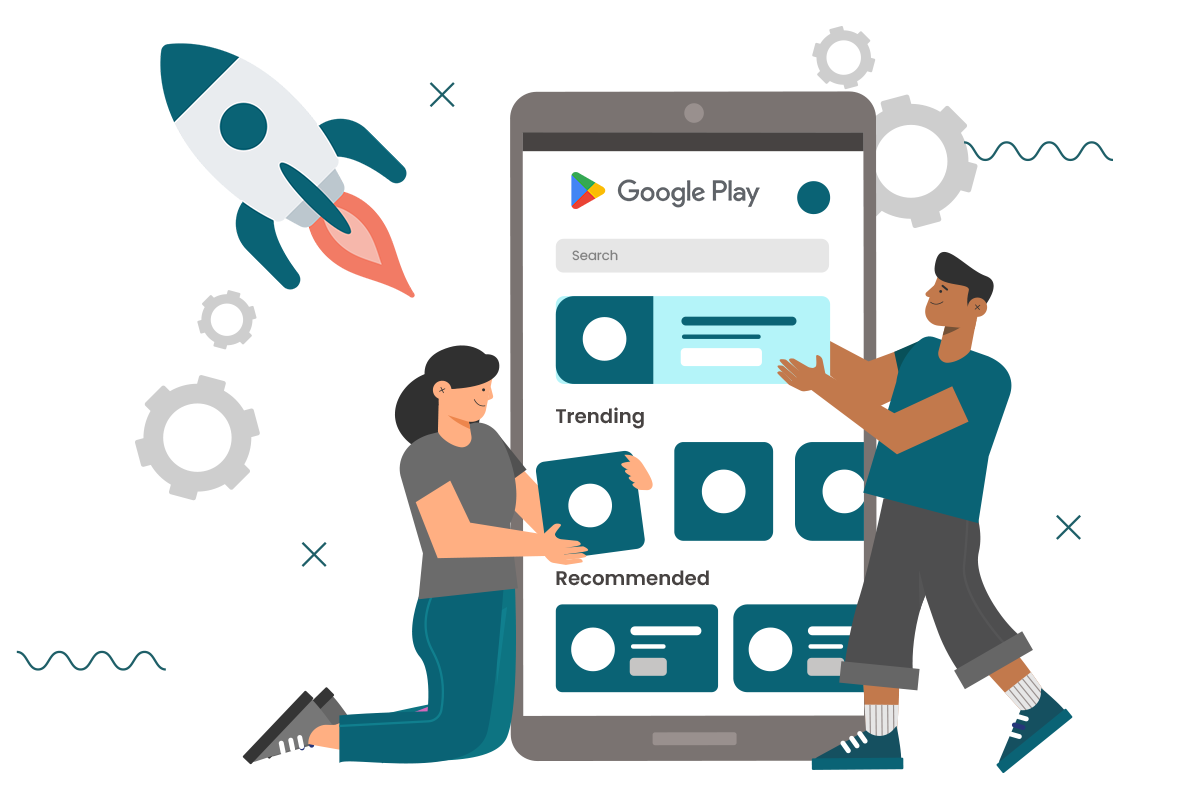With over 2.5 billion active Android devices globally, publishing your app on the Google Play Store provides an unparalleled opportunity to expand your reach, grow your brand and generate revenue. However, getting your app on the Play Store involves more than just uploading files. From meeting Google’s policies to optimizing your store listing, every detail impacts your app’s visibility and success. In this thorough article, our WebsCare research team has compiled all steps of launching your app on Google Play from preparation and development to submission and post-launch strategies. Whether you are a first-time developer or a seasoned pro, this guide is designed to simplify the launch process and set your app up for long-term success.
How Are Small Businesses Driving the Growth of Pakistan’s IT Sector? Let’s read more about it.

Step-by-Step Process for Uploading Your App to the Google Play Store
Here is the complete guide to publishing an Android App on Google Play in 2025, mentioned as:
- Preparation Before Launch
- Get Your App Ready for the Play Store
- Upload and Configure Your App
- Pricing and Distribution
- Review and Launch
- Post-Launch Strategies
Preparation Before Launch
Before you even think about uploading your app to the Google Play Store, you need to do some serious groundwork. This is one of the most important phases because a well-prepared app stands a much better chance of being successful once it goes live.
Define Your Goals and Audience
Before development, clarify what your app does, who it is for and how it stands out from the competition. Conduct market research to:
- Identify your target audience.
- Analyze competitors’ apps.
- Understand the features that resonate most with users.
Build and Test the App
Ensure your app is fully developed and thoroughly tested across various devices and screen sizes. Key steps include:
Functional Testing
Check that every button, link and feature in the app works the way it should. For example, if it’s a food delivery app, make sure the cart adds items properly and payments go through.
Compatibility Testing
Make sure the app runs correctly on different Android devices and versions. Android phones come in many shapes and sizes, so your app needs to work across the board.
UI/UX Testing
This tests the user interface (UI) and user experience (UX). Is the app easy to use? Is the design clean and intuitive? This helps ensure people won’t get frustrated and delete the app.
Security Testing
Protect user data by checking for security weaknesses. If your app handles logins, payments or personal info, this step is especially important.
You can use tools like Firebase Test Lab, Android Emulator and real device testing for comprehensive quality checks.
Get Your App Ready for the Play Store
Before you can publish your app on the Google Play Store, you need to go through several preparation steps to meet Google’s requirements and ensure a smooth launch. This phase is important because it sets the foundation for your app’s visibility, credibility and user appeal.
Create a Developer Account
To publish on Google Play, sign up for a Google Play Console account using a Google account. A one-time registration fee of $25 is required. This fee allows you to publish as many apps as you want under the same account. Once registered, you will have access to the Play Console where you will manage your app’s submission, updates, user reviews, statistics and more.
Prepare Your Assets
Google Play requires a variety of assets for your app listing:
| Asset | Description | Requirements/Format |
| App Name | Clear, concise and keyword-optimized title for your app | Max 30 characters |
| Short Description | Brief summary of your app’s main value | Max 80 characters |
| Full Description | Detailed overview of the app’s features and benefits | Max 4000 characters |
| Screenshots | High-quality visuals showing the app in use | JPEG or 24-bit PNG; at least 2 screenshots |
| Feature Graphic | Promotional image displayed at the top of the app listing | 1024 x 500 pixels |
| App Icon | Icon that represents your app on the Play Store and devices | 512 x 512 pixels; 32-bit PNG |
| Promo Video | (Optional) Video demo of app functionality hosted on YouTube | YouTube link |
Generate a Signed APK or AAB
Android apps are now required to use the Android App Bundle (AAB) format for new apps. Sign the bundle using Android Studio’s Build > Generate Signed Bundle/APK option and ensure you follow Google’s signing guidelines.
Upload and Configure Your App
Once your app is built and ready to go, the next step is to upload it to the Google Play Console and set up all the details that will be displayed to users on the Google Play Store. This step ensures that your app not only becomes available for download but also looks professional and trustworthy to potential users.
New App in the Google Play Console
Create a New App in the Google Play Console by following these steps:
- Go to the “All apps” section and click Create app.
- Choose a default language, add your app name and indicate if it’s an app or game and whether it’s free or paid.
Set Up Your Store Listing
This section is where you customize how your app appears on the Play Store. These details help users decide whether they want to download your app. Fill in all necessary fields, including:
- App details (title, description).
- Screenshots, icon and graphics.
- Categorization (app type, category, content rating).
- Contact details (email, website and privacy policy URL).
App Content
Provide additional information such as:
- Privacy policy: Link to your privacy policy hosted on a publicly accessible URL.
- Content rating: Complete the content rating questionnaire honestly.
- Target audience: Specify age groups and whether the app is for children.
- Ads declaration: State whether your app contains ads.
Pricing and Distribution
This step in the Google Play app publishing process determines how your app will generate revenue and where in the world it will be available. Making the right choices here is essential for aligning your app with your business goals and target users.
Choose Your Monetization Strategy
- Free or paid: Once published as free, you can’t change it to paid.
- In-app purchases: Configure in Google Play Console if applicable.
- Subscriptions: Define pricing tiers, duration and benefits.
Country Distribution
After finalizing your pricing model, the next step is to decide where your app will be available. You can choose for a global rollout, making your app accessible in all supported countries to maximize its reach or choose a selective rollout if your app targets specific regions such as those with particular languages or regulatory requirements. This approach helps modify your launch to your ideal audience. Importantly, you can always expand to additional countries later as your app grows or becomes localized for new markets.
Review and Launch
This phase is all about making sure your app is ready for public release. It includes testing options, running quality checks and finally submitting your app to go live on Google Play.
Internal Testing (Optional but Recommended)
Use Google Play’s internal, closed or open testing tracks to gather feedback before full release.
Pre-Launch Report
Run a pre-launch report using Firebase Test Lab to get insights on performance, security and compatibility.
What are the essential tips for choosing the right WordPress hosting for a Pakistani business? Let’s read more about it.
Publish Your App
Once everything is configured and tested:
- Go to Release > Production > Create new release.
- Upload the signed AAB file.
- Fill in the release notes.
- Click Review release, fix any warnings and then Start rollout to production.
It usually takes a few hours to a few days for Google to review and publish your app.
Post-Launch Strategies
After launching your app, it is important to implement post-launch strategies to ensure its success. Use the Google Play Console to monitor performance by tracking installs, uninstalls, user ratings, reviews and technical issues like crashes and ANRs (Application Not Responding errors).
Monitor Performance
After launching the app, use tools like Google Play Console to track how your app is doing:
- Installs and uninstalls.
- Ratings and reviews.
- Crash reports and ANRs (Application Not Responding errors).
Respond to Feedback
Engage with users by replying to reviews. Address user complaints or concerns quickly to build trust and improve app ratings.
Update Regularly
Fix bugs and add new features to keep users interested. Every time you release an update, refresh the app’s description in the Play Store to highlight new features or improvements.
Promote Your App
Use digital marketing strategies like:
- Social media campaigns.
- Influencer collaborations.
- Paid ads via Google Ads or Meta platforms.
- App Store Optimization (ASO) to boost visibility in the Play Store.
Curious about how web development is shaping Pakistan’s digital future? Let’s read more about it.
Conclusion
Launching an app on Google Play is not just about uploading an APK or AAB file; it is a strategic process that requires attention to detail, user-focused design and ongoing iteration. In this comprehensive guide, the Tashheer research team outlines the essential steps for successfully launching your app on Google Play. By following this complete guide, you will set your app up for a successful debut and sustainable growth on one of the world’s largest mobile platforms. Whether you are a solo developer or part of a large team, being meticulous in your pre-launch planning, listing optimization and post-launch engagement is key to standing out in the crowded Android app marketplace.


